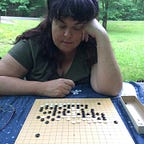My invisibility cane
A couple of years ago my arthritis advanced to the point where I need to use a cane for a while. (I’m not using it now thanks to physical therapy). At first, I was more than a little upset. Cane? I’m not even 50! But then I realized that walking slowly with a cane is better than just walking slowly. I was moving into the category of the visible disability and away from being able to hide it invisibly.
My orthopedist handed me a scrip and said, “Get a cane. It will help. Do you know how to walk with one?” And my cane adventures began.
Exactly how does one shop for a cane?
I’m 48, which is too young to be running around with a cane all the time. But, my knee hurt (arthritis), and the doctor showed me how to use a cane and that really took the stress off and relieved a lot of pain. I converted to the group of the cane people.
My husband sometimes uses a cane — just for show and affectation. He has an Irish blackthorn cane which doubles as a shillelagh. He has a tall, twisted Gandalf staff. Those were far to heavy for me to use for long. He has some Nordic-walking double sticks. I turned myself into a pretzel trying to use those.
Next, we headed down to the pharmacy — I had a prescription after all. In the assisted-living section with the big raised toilet seats sat the canes. These were lighter and maneuverable. Some even collapsed for small storage. But, to a one, they were ugly. Metal, black, the prettiest one was blue. I knew if I chose one of those canes, I would just look sad.
So, I went onto the internet — source of all things wild and interesting. And and boy did they. I was swept away into a world of dragon canes with crystals mounted along them. Canes that hid knives or flasks. Canes that transformed into a stool for sitting. But all those weigh too much.
I searched collapsible metal canes and that brought up more of what I wanted. They had hot pink canes, canes with playing cards printed on them, blue canes with yellow racing stripes, and one cane with gorgeous peacock feathers printed down in. And that one was marked half-off. I figured if I am going to have a cane — it should be bold and pretty — just like me.
I bought the bright peacock cane.
Invisible and hidden disabilities
Tons of us have invisible disabilities. We can pass for normal as long as we are not directly forced to exhibit our disability. They can be mental disabilities. They can be pain-causing disabilities. Or we may just be really good at covering things up and pretending things are normal.
Some of these are truly close to unseen. The elderly woman moving slowly through the grocery store is one. It might be bad arthritis. It might be the lasting effects of a stroke. It could be the young man standing in the corner and flapping his hands. He could be overstimulated by the hub-bub around him.
I thought that people seeing me with a cane and the cane would buy me a few privileges. People would be more willing to hold doors for me or give me more room to pass. It could buy a little more patience when I was slow to get up or down.
Boy, was I wrong.
If anything, the cane made me more invisible — as people actively tried not to see me. People taking up the entire shopping aisle would not scoot over to give me room coming through. Doors were let go to slam into me. If I dropped something and was having obvious difficulty picking it up, no one helped. If I dropped my cane, no one helped.
It was pretty awful. My visible disability rendered me invisible. Folks would turn away or scuttle sideways to enhance their plausible deniability that I was not there.
The one group of people who did see me was people with canes themselves. Men with canes would almost always hold doors open for me. Women did too, sometimes. I got a lot of comments on my cane. (It was pretty with peacock feathers drawn on it.) I noticed people with canes, too. It is almost as if the cane gave me and others 3D glasses to see the world differently.
It might be age, instead of the cane, that people were avoiding. We are really good at not seeing old people. How we changed! We used to venerate our elders. (Okay, I know I am aging if I was old enough to just type that.) Old folks and their problems are perhaps too much to deal with, even in extending everyday courtesies. We encourage old people to hide away and refuse to see them when they stay visible.
In Illinois, where I live, the DMV has a campaign called “Start Seeing Motorcycles”. My challenge to you is this: start seeing canes.
Keep an active eye out for canes (and walkers and braces etc.) You have to shift your vision to focus on points where your eyes do not normally focus. This works for bird watching, too. See if other parts of your vision shift along with it. I’m betting the world will look a lot different if you do.
